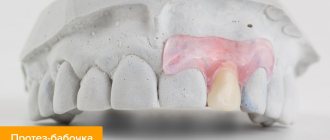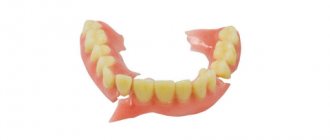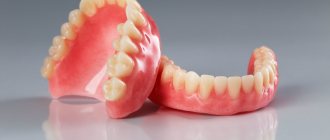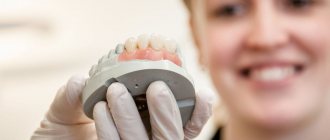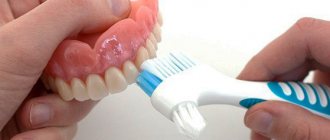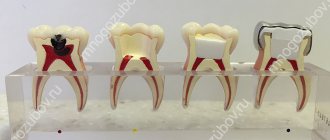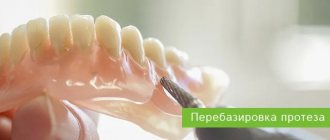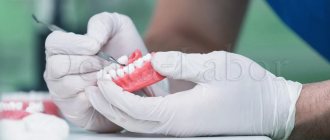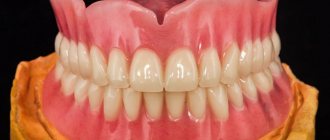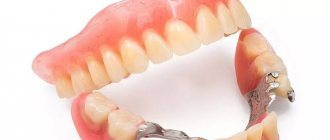When using removable dentures regularly, their high-quality fixation in the oral cavity is very important. The duration of the patient’s adaptation period to the new product depends on this. In the absence of reliable fixation, the manufacture of a new orthopedic structure is required. With prolonged use of the prosthesis, bone tissue atrophy begins and the configuration of the base of the product no longer follows the relief of the tissues of the oral cavity.
But repeated dental prosthetics is not always possible due to the patient’s financial capabilities, so the best option is to reline a removable denture rather than replace it.
What it is
Relining is the correction of an insert structure to improve the fit of the prosthesis to the gum and restore chewing functions. In addition, the rebased design should ensure the correct bite of the teeth when closing and opening the jaws.
If you neglect this procedure, you can get the following complications:
- breakage of the prosthesis;
- deformation and loss of supporting teeth;
- inflammation of the soft tissues of the oral cavity.
What is denture relining?
A typical relining of a prosthesis is a whole set of procedures that involve modernizing the base of the structure to improve basic functions. With its help, they achieve a tight fit to the jaw, reliable fixation, eliminate inconvenience, correct defects and evenly distribute loads. In fact, relining a removable denture is aimed at improving the performance properties of the product.
Typically, denture relining is prescribed by your dentist during a routine examination. It is recommended to do it at least once a year. If you feel discomfort or pain while using the prosthesis, then this is a reason to contact a specialist without waiting for the next visit.
Indications for the procedure
Those who wear removable dentures need to visit a doctor once every six months for consultation and necessary relining. The procedure is necessary in the following cases:
- visible defects on the prosthesis;
- change in gum relief due to prolonged wear;
- unreliable fixation of the removable structure;
- transformation of the lower part of the face (height).
You cannot reline a prosthesis if it has significant defects and damage: in this case, a replacement is required. In case of inflammatory diseases of the oral cavity, relining is carried out only in laboratory conditions, but with the possibility of making impressions.
If the patient has an allergic reaction to plastic, a special laboratory will also be needed to reline the dentures.
Features of relining nylon structures
Patients often wonder whether it is possible to reline nylon dentures. Experts answer that it is possible, but not necessary. Firstly, applying a layer of material to the base leads to its thickening. This may cause the structure to lose elasticity and increase the likelihood of poor fit and discomfort.
The second reason is the increased hygroscopic properties of nylon. During operation, the material became “filled” with microorganisms, the complete removal of which is not possible. As a result, the new material applied during relining will peel off.
On a note! Experts note that the cost of relocating a nylon product can be compared with manufacturing a new one. In addition, it must be taken into account that the service life and quality of the restored structure are significantly reduced.
Clinical method
The procedure for changing a device can be carried out in various ways. If the defects are minor, relining can be done directly in the dentist's office. It will take only 30 minutes to restore the damaged base.
Procedure steps:
- The doctor examines the oral cavity and evaluates the bite and position of the prosthesis, determines the places where the product presses on the gums.
- Evaluates the conformity of the bone relief and the adjacent structure.
- Starts working with the drill. The carborundum head gradually cuts off a layer of polymer no more than 1 mm from the inside of the base.
- The teeth and mucous surface of the mouth are treated with Vaseline, which prevents the adhesion of the liquid polymer.
- Then the specialist prepares a solution and applies it to the surface of the prosthesis.
- After 10 minutes, the prepared denture is put into place, and the patient closes and opens his teeth. The doctor models the edges of the product.
- After removing the structure, it is placed in hot water for some time, where it hardens and polymerizes.
- The specialist again begins fitting and adjusting the prosthesis so that the edges are in tight and comfortable contact with the gums.
- Finally, excess material is removed and the artificial teeth are polished.
This method is convenient because relining can be completed within one to two hours during one visit to the doctor.
Clinical method
The following factors can be considered as disadvantages:
- The liquid polymer has a toxic effect on the oral mucosa;
- The materials used in the work are of low quality, unlike those used in laboratory conditions;
- Such a prosthesis may not be strong enough due to air bubbles trapped under it.
However, many people prefer this relocation method.
Who needs relocation and why?
After installing a denture, the load on soft and hard tissues changes. Mechanical pressure on the mucous membrane contributes to its compression and the development of the inflammatory process.
OPERATIVE PROSTHETICS WITH ACRYLIC PROSTHETICS - from RUR 180,000.
Re-prosthetics with an acrylic bridge on a metal frame (all included) up to 12 units.
Save RUR 30,000. Call now or request a call
In addition, the products do not protect against degenerative changes in bone tissue (they continue to occur even after prosthetics), which ultimately leads to a violation of the tightness of the structure and weakening of fixation (that is, the bone sags, and does so very unevenly). Therefore, the purpose of relining a complete or partial removable denture is to correct the base and restore tight contact of the gums and supporting teeth with the product. The procedure allows you to achieve the following:
- promptly identify and eliminate minor defects,
- prevent problems with supporting teeth,
- increase the service life of the structure,
- prevent disruption of the closure of the upper and lower jaws,
- optimally distribute the load on the mucous membrane.
On a note! Relining is required not only in the case of removable products, but also in the process of using conditionally removable dentures, which are fixed on implants. Most often, these are immediate load protocols (all-on-3, all-on-4, all-on-6). The fact is that after implantation and immediate installation of the structure, the load on the bone tissue increases, because the patient has the opportunity to immediately use the teeth for their intended purpose. This leads to increased regeneration, growth of new cells, increase in volume and other changes requiring correction of the device. That is, the bite changes again, so you need to slightly change the position of the prosthesis.
Laboratory method
Work in the laboratory is carried out in cases where the prosthesis is manufactured for the first time and in cases of serious violations committed during manufacturing. And also with reduced bite heights. In this case, harmful toxins do not affect the mucous membranes of the mouth, and the product looks more aesthetically pleasing than with the clinical method.
Relocation stages:
- The prosthesis is removed and sent to the laboratory, where the top layer of plastic is removed.
- New dental impressions are taken from the patient.
- The old denture and the new impression are placed in a mold into which the plaster mixture is poured.
- The impression is then removed and the space is filled with a polymer material that bonds to the item.
- At high temperatures, the applied material polymerizes.
- The finished structure is removed, cleaned of excess and polished.
- The prosthesis is tried on the patient. If necessary, the bridge is adjusted again.
- If a person does not experience discomfort during installation, chews easily, closes his jaws, the relining is completed.
Relining is carried out using hot polymerization plastic
The big disadvantage of this method is the length of the wait and the need to visit the doctor several times. Production time takes from two to five days.
How much does it cost to reline a removable denture?
Prices for repositioning a prosthesis in Moscow are approximately the same in all clinics. First of all, they depend on the chosen technique and the complexity of the work. The cost formation is also influenced by the material from which the structure is made. Relining a clasp denture is the cheapest option, but the Acry-Free type design is usually the most expensive.
Our clinic’s specialists have sufficient qualifications and experience to perform prosthesis relocation of any complexity. Early treatment will allow you to identify defects at the initial stage, which will allow you to correct them without waiting for discomfort to arise during wearing.
The procedure for relining a removable denture practically does not affect the patient himself. Even the clinical method does not cause much discomfort, and the time it takes can be compared to a preventive examination. The main thing is to choose the right doctor. A good specialist will detect emerging problems in a timely manner and perform the procedure quickly and as efficiently as possible. These are the doctors who work in our clinic, providing their services at a reasonable price.
Reduced bite height
This is a case that has its own characteristics, since during atrophic processes the indicator of the central ratio of occlusion changes. To take the necessary measurements, it is necessary to place a small layer of thermoplastic resin between the teeth to reline the dentures in the mouth.
After this, the specialist must measure the height of the lower third of the face with the jaws closed and at rest. In this way, it is possible to achieve the most comfortable interocclusal gap, at which the patient will feel comfortable chewing food and closing the teeth normally.
For such indications, relocation is performed only in the laboratory and takes several days. The cost of this procedure is more expensive than usual.
Material used
Gasket materials used for relining are classified into three groups:
- solid permanent – their average service life is about 4 years;
- soft semi-permanent – recommended for use in clinical cases when the patient experiences discomfort while using prostheses while observing all parameters and characteristics.
Most often, this is the lower jaw, since it is there that there is less space to evenly distribute the load; - temporary soft ones - their service life is no more than 2 weeks. The materials are specially developed for use for medical reasons.
The most common:
- Sofreliner S;
- Mollosil;
- Rebase II;
- GC Coe-Soft.
The process of processing prostheses made from various materials is presented in the video.
Permanent Solid Padding Materials
To ensure a tight fit of the prosthesis to the mucous membrane, a solid lubricant is used.
There are two methods for restoring the fastening of the structure : cold-curing acrylic plastic, used during the restoration of a removable jaw, and hot-curing acrylate applied in the laboratory - a fabric identical to materials for the manufacture of dentures.
The first type of cold-curing resin contains methyl methacrylate , which injures soft tissues and causes discomfort in patients. Hot-curing plastics contain other components (polyethyl methacrylate - PEMA and butyl methacrylate), which do not harm the mucous membrane, but at the same time reduce the glass transition temperature.
A definite disadvantage of cold-curing plastic is an unpleasant taste, loss of color over time, and an increased exothermic reaction. It is also quite difficult for the dentist to measure the required amount of material when removing a denture or to determine the thickness of the layer for relining.
Important. Since the permanent adjustment of the artificial jaw is performed for a long time (two years), it is worth giving preference to the method carried out in the laboratory.
Semi-permanent soft lining materials
Such materials are used when the patient is unable to wear a prosthesis with a solid base due to the destroyed edge of the alveolar process.
Among soft gaskets, there are silicone polymers , which have a low glass transition temperature, and plexiglass - or in other words polymethyl methacrylate (PMMA), a thermoplastic plastic. To lower the temperature of the latter, plasticizers are used - substances that add plasticity to polymers.
Silicone polymer (rubber) hardens when heated using an organic compound - benzoyl peroxide, or at room temperature using tetraethyl silicate ether.
The weak point of the material is considered to be insufficient adhesion to the base of the PMMA prosthesis, which threatens the destruction of the connection. Silicone rubber also leads to the development of stomatitis.
Another type of soft spacers is acrylic , which is firmly connected to the base of the dental chewing device.
There are polymers that can be dissolved by plasticizers and systems of copolymerizing plasticizers..
In the first group, the polymer is a powder - a mixture of PEMA and PMMA and a liquid - MMA (methyl methacrylate ether), containing 25-50% plasticizer. Organic compounds of polymers are gradually leached and the substance ceases to be flexible. To protect the material from destruction, follow the denture cleaning regimen.
The second type of compounds withstands dissolution . The liquid is combined with either PEMA or copolymers (l-butyl and ethyl methacrylate). At room temperature, the substance is solid, which helps to process it better, and it softens at oral temperature.
Reference. The duration of wearing soft cushioning materials is no more than six months.
Temporary soft cushioning materials
Tissue conditioners are temporary extremely soft dentures applied to the base of the dental structure in order to equally distribute chewing force and pressure and cope with the inflammatory process of the oral cavity.
The substance consists of PEMA powder , which when mixed with ethyl alcohol, an aromatic ester and a plasticizer creates a gel. Alcohol and plasticizer are leached, so the conditioner is periodically renewed to speed up the healing of the mucous membrane. You should clean your denture regularly, otherwise bacteria will appear.
An alternative is to reline the prosthesis from polyamide, polyurethane, polycarbonate, etc. Their difference is increased flexibility, which is why they are often referred to as “flexible prostheses.”
There are modern removable dentures that have the advantages of classic acrylic dentures and flexible nylon ones - among them, the relining of the Acri Free prosthesis stands out.
Like nylon structures, they are elastic and comfortable to wear , and, like acrylic ones, they are strong, durable, adjustable and repairable.
Removable dental structures are made from non-allergic material.
They are fixed on the teeth using pink plastic clasps that match the color of the gums.
Price
The cost of the service is determined not only by the method of its implementation, but also by the following direct and indirect factors.
Direct:
- price of the material used;
- equipment used;
- the size of the structure and the volume of work carried out.
Indirect:
- region of residence – as practice shows, in metropolitan clinics and large cities this service costs 15–20% more than in small towns and settlements;
- status of the medical institution and the level of professionalism of the doctor.
On average, based on the above, the cost of the procedure looks something like this:
- clinical relocation – from 3,700 rubles;
- laboratory - from 6,200 rubles.
It is worth noting that if prosthetics and subsequent relining of the structure are carried out in one place, very often clinics offer good discounts to their regular customers.
